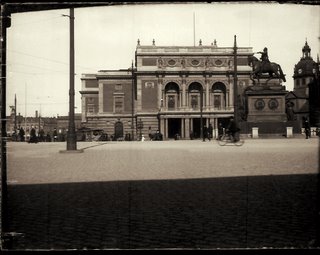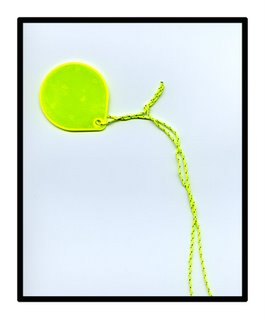06 November 2006
Invited Photographer: Ken Richardson
Ken's vision has always fascinated me. It's regular and irregular, silent and singing, totally nuts and incredibly sane all at once. I asked him to share some of his new work with us, along with a few words about what he does. This all comes to us from somewhere in Texas.

My images carry no agenda, there are no hidden meanings per se but they are part of what makes me whole, or broken, as the case may be. It is rare that I photograph with a preconceived idea or intent. Things usually just occur as a natural course of evolution. I know that what I do choose to photograph carries a signature to my soul. The things I see and the things that motivate me to shoot resonate somewhere within my psyche, like a momentary flashback of a dream I can’t quite remember in totality. Segmented thought patterns, not knowing the beginning or ending, my vision stuck somewhere in between. As a course of progression, I am motivated first to impressions that I perceive with my eye and mind and in many cases subject almost plays a secondary role.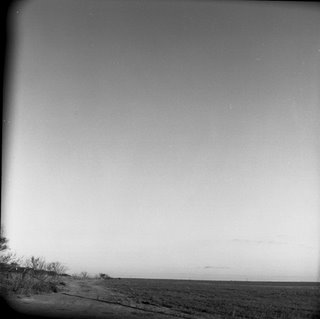

While I am certainly well versed and adept with the technical issues of film based photography, I in no way consider myself a technical purist nor is it my goal to achieve perfection to the point of sterility. Some of my favorite images carry the imprint of textbook defined technical miscues either through accident or intent. I like things with a bit of quirkiness and as a self-taught photographer adhere to no rigid regime of what “good photography “ is or isn’t. In general, if the final print says something, and the technical issues of tones and contrast have been executed to my satisfaction, then I am content both with my work and the work of others.
. . . . For me part of the enjoyment of photography is working with my eye, hands, and mind to produce the final print. There is nothing for me that compares with the gratification and sheer awe that occurs as a print comes up in the developer. In short, it’s pure magic. . . .
It is my hope that my images capture a sense of time, place, and most importantly sparks some memory or emotive response for the viewer. To that end I continue to learn, attempt to see, experiment, and listen to my soul.
Thank you so much, Ken, for sharing a bit of yourself with us.
more of Ken's work can be seen here. Invited by Jeanne Wells.
going south...
It kind of gets on my nerves sometimes.
05 November 2006
Abdominal Pleasures (American Homes)
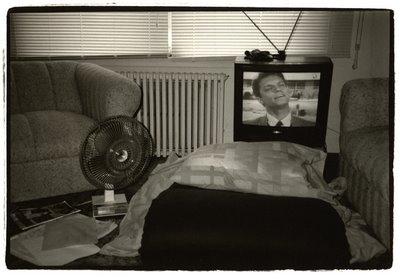 photo: abeku
photo: abekuFormula F
Not even two months have passed since it was set up and The F Blog is already becoming an addiction to many people. It´s a place where you will find good photography around the clock, invited guests like Gerry Johansson, Diego Levy, Michael Kenna, Joy Goldkind, Alec Soth, Joanna Kinowska and many other top photograhers.
The F people also invites completely unknown, but equally talented photographers from around the planet. This blog is absolutely unpredictable. There is no editor, there are seventeen of them! To me they are like a bunch of 21st century Dadaists, without being aware of it. And certainly not recognizing it.
By the way; the letter F originally probably represented either a "hook" or a "club". In photography, f denotes the focal length or the f-number.
- Nenne Gulden
Guest: Kita McIntosh

In her own words:
Well...Chris said I can say anything, even wax lyrical about my knitting techniques...indeed ..actually...knitting can be very creative.
 What I did was, I knitted Antony, my hermaphrodite doll. (after my fave singer) . Antony has a bag across his shoulder (as the real Antony always wears). Content: a pair of tits, a knitted dick and a knitted fanny. I just wanted to give Antony the..choice... Life is about choices isnt it? Well it should be. AH but wait for it! The thing is, I created Antony so that then I could shoot him, you see. With my cameras that is. And THAT is the connection with photography, as this is a photo place, after all. See? There was a logic..
What I did was, I knitted Antony, my hermaphrodite doll. (after my fave singer) . Antony has a bag across his shoulder (as the real Antony always wears). Content: a pair of tits, a knitted dick and a knitted fanny. I just wanted to give Antony the..choice... Life is about choices isnt it? Well it should be. AH but wait for it! The thing is, I created Antony so that then I could shoot him, you see. With my cameras that is. And THAT is the connection with photography, as this is a photo place, after all. See? There was a logic.. I also knitted Ariosto and took shots of him posing among a herd of cows. As Chris says, bovines are extremely photogenic, especially if there is an Ariosto among them. Ariosto is striped, 2 ply wool, in case you are interested. Needles size 3 and a half, if I recall correctly.
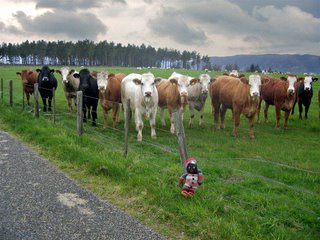
I once hang a fork from a washing line and called it "the suicidal fork".
That,s me really, in a hazelnut shell (a walnut would be too pompous). Art? Dont know nothing about art. I am a doodler...take a piece of paper, a pencil and shut my eyes, and let my 3 cells guide my hand....it works! For me anyway....
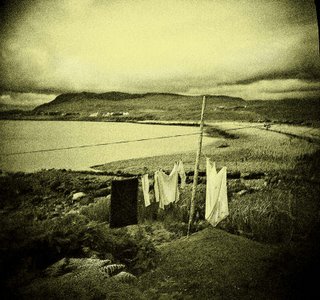
You can find more of Kita here. Invited by Christofer Grandin.
04 November 2006
fotos encontradas
 oohh
oohh
I love this photo, the moment, his face. I spotted it on the bottom of a very dirty gutter.
If you are looking for miracles and magic, Latin America is a good place to start. Finding Pablo and his project was pure joy to me. This is what he says in an email: I am not a photographer... Oh well, I do take photos - but merely out of trashcans.
So let´s go to Buenos Aires and meet this man and his mission. In some way Pablo makes me think of Amélie Poulain. Why is he doing this? My guess is that it has something to do with love – love of a city and its people.
Don´t forget to visit Pablo´s site (in Spanish and English)
invited by ulf fågelhammar
Found photos
'But there is no stone in the street and no brick in the wall that is not actually a deliberate symbol -a message from some man, as much as if it were a telegram or a post-card. The narrowest street possesses, in every crook and twist of its intention, the soul of the man who built it.' G. K. Chesterton .
I started with this project by the end of the nineties. I already had some collections and loose photos but I did not know what to do with them -apart from showing them over and over to friends. I was quite idle at work and Internet was new for me, so I spent whole days on the web. Then I happened to google the words "found photos" and found inspiration in the many sites devoted to found photos. But then I found (!) the big difference between those beautiful photos and mine:
most of them were not found but rather bought for pennies in garage sales and flea markets, while mine were 100% trash. I had the scanner, the Internet connection and lots of time, so I thought it would be fun to show everybody my findings on the web.
A good example of an ugly photo that somebody tried to erase from the surface of earth.
All of the photos and items that are shown at my site have been found by me in the streets of Buenos Aires. Most of them were inside Sunday's trashbags, many others on the sidewalks. A very small portion of them seem to have been lost by their owners.
This is a strictly personal project, and that's why there are no other photos here than the ones that I have found himself. I do not buy photos, but I accept the ones that they give me and keep them in
separate boxes. Some people ask me why don't I restore my damaged found photos through software: I tell them that I found these photos in the very street, and that is their true nature, so if I should restore them, it would be to deny or hide their origin -not to say it would be quite a job to do. A guy once dared to restore some of them just to show me the results. The results were truly funny and I found it quite hard to explain him that I like my found photos just as they are.
-Pablo Cruz Aguirre
The place seems a sordid nightclub. There's something Tex Averish in his face, no?
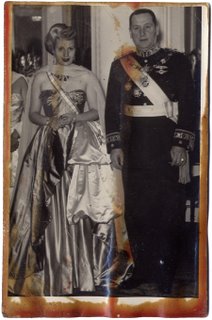 peron y evita I don't know if this is one of many copies that were handed as propaganda or the stains are blood or merely water that worked on the chemical stuff of the paper.
peron y evita I don't know if this is one of many copies that were handed as propaganda or the stains are blood or merely water that worked on the chemical stuff of the paper.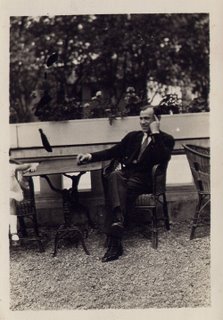 groma One out of the four boxes of photos that I have is devoted to this man, Samuel Gromatzky. Someday I will finish ordering this collection and I will put it in the site.
groma One out of the four boxes of photos that I have is devoted to this man, Samuel Gromatzky. Someday I will finish ordering this collection and I will put it in the site. trio
trioI think this photo could only be taken in Buenos Aires.
 linda
lindaI think this woman lives on the house next to mine.
Guest: Sune Karlsson
Perhaps five or six years ago I saw two pictures that really got my mind going. In one photo I saw three laughing nuns and in the other picture a man with a mask walking down the street with his hands in his pockets. Both pictures told stories, different ones every time I looked at them. Through the years the photographs have continued to fascinate me, especially when I've been able to see the actual prints. The photographer is Sune Karlsson of Torsby, Värmland, who I hereby proudly present as a guest on the F blog. The photographs below are a few of the many interesting pictures from his decades as a
enthusiastic photographer. Some more of his photographs you can see here.
Invited by Fredrik Skott.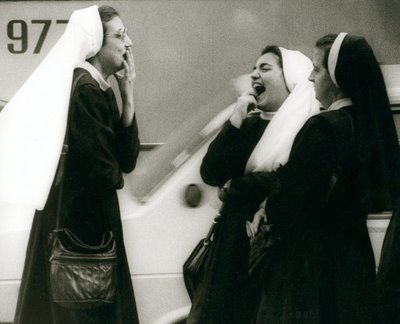



03 November 2006
Guest: Diego Levy
The world is one. And the world is real. But the reality of people living in this world differ from place to place, depending also on living conditions, education, gender and many other things. I have made it my mission to introduce good photography from Spain and Latin America on The F Blog.
My first invitation is Diego Levy, a young and very talented photographer from Buenos Aires, Argentina. The pictures shown here hit me hard, it was a similar feeling to me like watching the film Amores perros. Diego sent me eight pictures, two from each city; Buenos Aires, Rio de Janeiro, Medellin and Mexico City. I decided to publish all of them.
invited by ulf fågelhammar
See more of Diego Levys work here.
The introduction to Levy´s pictures is written by Juan Travnik, Photographer, Buenos Aires; Director, Fotogalería del Teatro San Martín, Buenos Aires: Photography
INTRODUCTION
Just some decades ago, in most of the quarters of Buenos Aires there was a frequent setting to be seen: neighbors talking among them for hours seated in front of their houses. These situations, utterly uncommon today, were typical scenes of summer evenings. However, after the political struggles and state terrorism of the brutal dictatorship of the second half of the ‘70s, there followed
a new phenomenon of crime and street violence of another origin, related to marginal sectors and crime, which has grown fast as from the ‘80s. During the year 2000, Diego Levy started to get involved in these issues, which had not yet played the leading part in the media they would later do. Except for some extraordinary cases, they were covered by most of the newspapers within the
police section, and only the most resonant ones would have a headline coverage.
These first photographs that Levy turned into a personal essay, began to shape the series Sangre. Later, he went on searching similarities and differences in the cities of Rio de Janeiro, Medellín and México DF.
Since he worked without the generally slanted pressures of news editing offices,his straight look and his sharp and forcible frame, did not search clichés or low blows. His images show what is there in fact: bloody scenes of violence, wounded and dead people who may turn up just around any
street corner. Scenes which have now become almost daily for the inhabitants of these cities. They are either their protagonists or witnesses; they may watch them on television or read them in the papers. Such images are many times used unscrupulously, in perfectly calculated doses, to boost
sales or to influence on public opinion and exert pressure on hidden political maneuvers.
The increase in violence and crime has peculiar characteristics in each city and in each country, but it has also common elements which always go in hand with neoliberal economic policies and high levels of corruption, which brought about strong economic concentration, huge inequalities and
a devastating social exclusion. Out of this circuit and away from such interests, Levy introduces the topic in a different discipline, that of visual arts, field in which it is uncommon to see such cruel and touching images. Like the great exponents of suspense novels or films noir, he portrays crime and death that nowadays brutally mark life in the big cities of Latin America.
